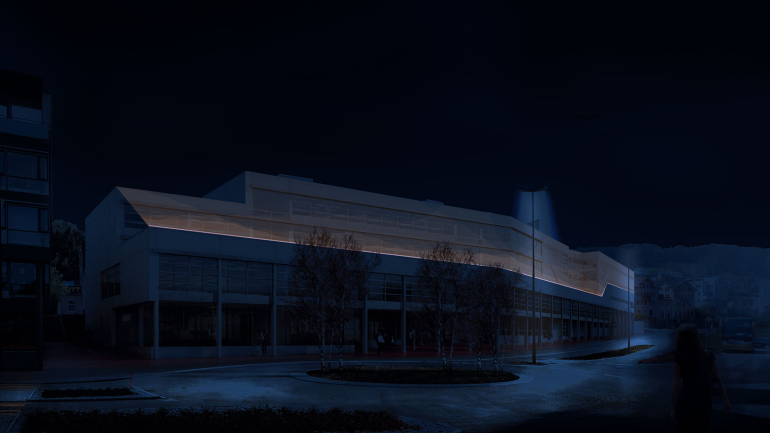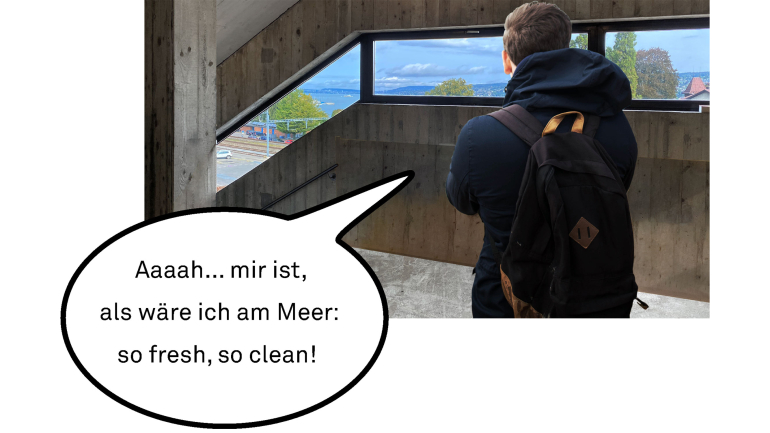Das Schiff
Starting position:
In 2020/2021, the structural engineering office of the canton of Zurich (Hochbauamt HBA) organized a study commission for the artistic design of the old and new building of the educational center Horgen by inviting four artists. The user of the building is the educational center (Bildungszentrum BZZ), the building owner is the canton of Zurich. The lead management and project management lied with the HBA of the Canton of Zurich.
Proposal:
«The ship is the heterotopia par excellence. In civilisations without boats, dreams dry up, espionage replaces adventure, and the police the pirates [...]»
— Michel Foucault, «Of Other Spaces, Heterotopias»
For young people, an apprenticeship is a ship that helps them get from point A to point B. Full of the spirit of discovery they set off into the uncertain future, undertake a long journey to unknown shores, follow their pioneering spirit or have a clear plan. One thing is certain: this journey will change them. Occasionally, the destination is lost from sight, re-surveyed by radar or approached with great difficulty. The crew will change the students, their fellow students, the teachers and also the staff. Das Schiff is an invitation to all students to dream their future, to fight for their goals, to take care of themselves and others and also to take care of the ship.
Das Schiff can be perceived in two ways, both of which are part of this proposed project.
A. Performative, structural interventions: Ten interventions fixed and functional in themselves (billboards, scents and lights).
The interventions include classic art-on-structure elements such as sculptural and pictorial interventions that in a sense provide the framing for the narrative that unfolds in the course. They provide a link to the ship allegory that anchors the narrative locally.
B. Participatory radio play: Parcours over five stations in a narrative sequence, duration ca.1h.
The parcours plays with the contents of the building and opens possibilities for a discourse about current forms of vocational education, concerns of the users and questions for the previous and following generations - here it is about where the ship is heading and where it came from.
The location of the school building on the lake, the sheer volume of the long building, its deck-like construction into the six floors above and below ground, the slit-like view that one is offered from within the older part of the building as well as the overhanging surfaces in front of the newer part of the building inspired me to this image of the ship. On the other hand, I experience school buildings as spaces that reflect social relations in a special way by representing, negating, or reversing them. They are places that have a systemic significance and which incompletely implement the norms in force at a given time. They function according to their own rules. The same is true of a ship.
Contemporary school buildings are increasingly becoming beacons of new architecture. Caused on the one hand by the obligation to put public building projects out to tender as a competition and on the other hand by the growing sensitivity of municipalities for architectural branding, the school building is less and less committed to one style and rather forms a solitaire. What has not changed is the fact that they shape the students - first and foremost through their architecture. Therefore, I would like to give the architecture itself a special meaning in the narrative in order to bring this imprint into consciousness - the particularity of the fusion of old and new architecture forms the starting point for the story that unfolds along the artistic stations or interventions.
With its postmodern features, the building section from the 1970s clearly points in the direction of modernity - and thus references the ghosts from the past. The contemporary interpretation and continuation of the building in the new part of the building thus references modernity to a certain extent. This referential process has much to do with learning itself. We learn first and foremost through imitation and appropriation. The references to the past enable the creation of space for memories and thus also refer to the future. For without memory there is no future. This manner of memory and vision in material form forms the basis for a narrative that unfolds through the architecture. The narrative of the course is meant to function as a kind of sensory memory. This memory haunts our minds and poses questions about the ideas that haunt and will haunt us for some time to come.













